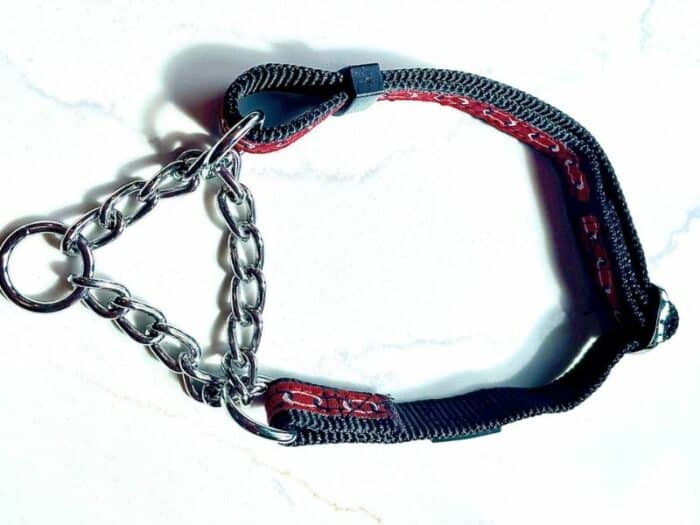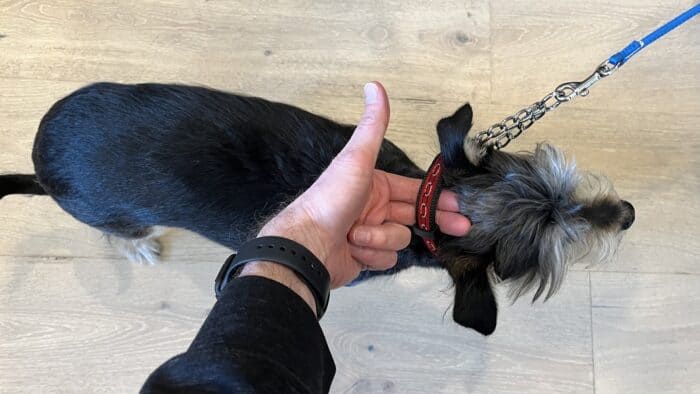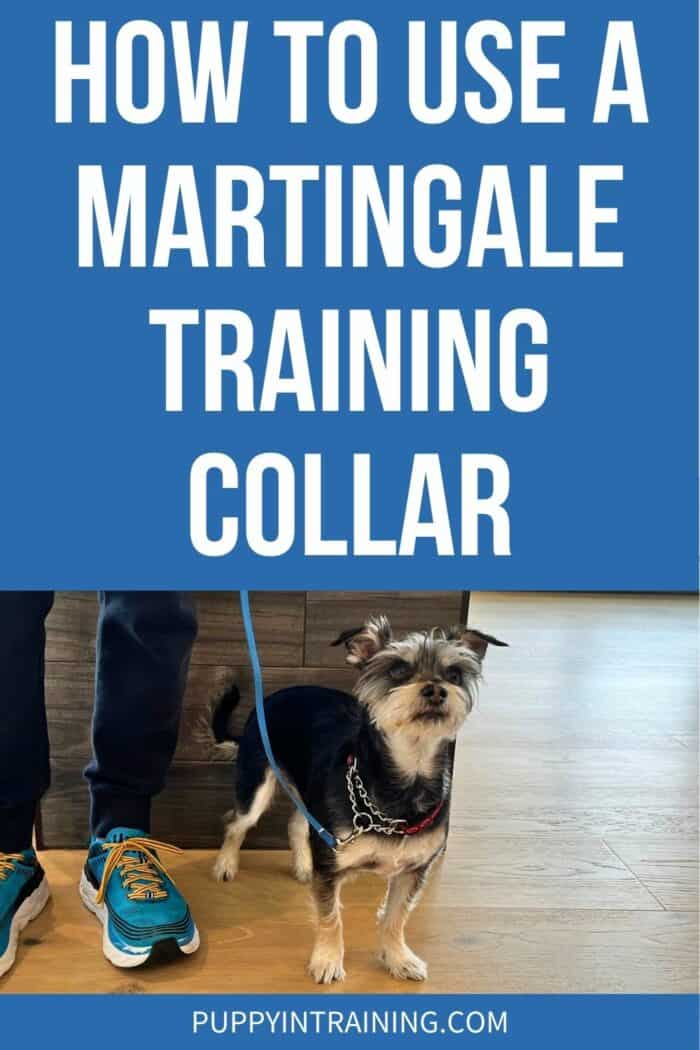How To Use A Martingale Training Collar With Your Dog
This post may contain affiliate links. We may earn money or products from the companies mentioned in this post.
Do you ever wonder what a good collar is to use when training your dog?
There are flat collars, training (choke) collars, prong collars, head collars, martingale collars… so many choices!?
I recommend to my clients to use a Martingale Training Collar.
In todays article I share tips and tricks on how to use a Martingale Training Collar when training your dog.

How To Use A Martingale Training Collar With Your Dog
I get asked a lot about what types of collars to use when training your dog.
There are many different types of collars which can all be useful for different situations and with different dogs.
We can explore those different collars in posts to follow but today I want to explain the Martingale Training Collar.
I like people to use a collar that gives them the most control but is safe and easy to use when training their dog.
There are a lot of benefits to using this collar which I will explain and then show you how to use the collar step-by-step.
Supplies you will need to get started:
Whenever we embark on a new training adventure, it’s important to be prepared with all the tools and supplies you will need.
For teaching our dog to wear and be comfortable using a new training collar, I recommend having treats on hand.
Some ideas might be small bits of cheese, chicken or kibble.
QUICK PRO TRAINER TIP: If you are looking for a good training treat, Colby recommends Crazy Dog Train-Me treats.
These treats come in small bits and multiple flavors depending on what your dog likes.
I categorize treats based on the value. A high value treat would be something special and particularly yummy. A low value treat would be something more like plain chicken or a piece of kibble.
Here are more examples:
- Low Value – A piece of kibble.
- Medium Value – Crazy Dog Train-Me treats.
- High Value – A piece of bacon or steak.
For working with a difficult task, I recommend a high value treat.
Other tools you will need are a leash and a Martingale Training Collar.
QUICK PRO TRAINER TIP: My friend Colby recommends the Multifunctional Service Dog Leash which he likes to use with his service dogs.
What is a Martingale Training Collar?
Martingale collars are a combination of a traditional flat collar and a D-ring on the top of the collar, which can be made of fabric or a small chain. Sometimes these collars are also called no-slip collars.
The collar is designed to fit loosely around your dog’s neck but is able to tighten if your dog pulls or tries to back out of the collar.
The tension causes the smaller D-ring loop to tighten which then tightens the larger flat collar.
The benefits of using a Martingale Collar:
I use these collars with my client’s dogs for many reasons:
Safety:
There are multiple reasons why using this collar is safer than others people might choose.
Some dogs who are fearful have a tendency to try to slip or back out of their collars. Some breeds that this could be an issue with are Whippets, Greyhounds, or Shetland sheep dogs.
The reason for this is because they have narrow necks and smaller heads so conventional collars can slip off.
I have a rescue dog in training whose owner named her Chicken because she is afraid of everything. She cowered and pulled back on her leash whenever they took her out to walk.
We use the Martingale collar with her so she cannot back out of her collar and get away when she is afraid and they can give her a slight correction to get her to walk by their side and feel comfortable and confident.
Control when on leash:
When we teach our dogs to “heel”, ideally they are next to us without tension on the leash. These collars are designed to slightly tighten when there is tension on the leash.
This gives a small correction to the dog to move back into place by your side instead of pulling forward or falling behind.
Correction without choking:
There are some training collars that are designed to tighten when there is tension on the leash, but sometimes they may tighten too much or they may not release quickly to signal to your dog that they are behaving correctly.
This can choke your dog or be harmful. The Martingale collar is designed to only tighten a certain amount so there is no way to choke or harm the dog.
The collar also releases when there is no tension to signal to your dog that have done the right behavior.
How to properly use your Martingale:
Step 1: Adjusting the collar to fit your dog properly
When using any collar it is important to be sure it fits your dog properly and this is especially important with a martingale collar.
The collar has two loops that work together to enable the collar to tighten and then release when a correction is given.
The smaller of the two loops on the top of the collar is called the “control loop” which tightens when there is tension on the leash.
The larger loop that fits around the dog’s neck is called the “adjustment loop”. This loop can be made larger or smaller depending on the size of your dog.
The “adjustment loop” should fit around the dog’s neck comfortably and the two sides of the “control loop” should touch without choking your dog when pulled tightly.
The collar should fit loosely when there is no tension on the leash. Because the collar fits loosely, it should also be removed when you are not using it for training because it can get caught on something.

Step 2: Using your collar correctly
Once the collar fits your dog correctly it is time to learn how to give a correction to your dog.
The collar should be positioned high up on the dog’s neck, close to the back of the ears.
This will give you the most control and also allow you to give your correction with the least amount of force. This placement also puts the dog in the perfect “heel” position.
When you begin your training session, be sure you can fit two fingers (see pic below) between the collar and the dog’s neck.
This fit of the collar evenly distributes pressure around the entire neck when the dog pulls.
This is different from a standard flat collar which puts all the pressure on the front of the dog’s neck and pushes on the trachea.
If you have a strong dog that pulls a lot, this can cause damage to the dog’s trachea.
Step 3: Giving your dog a “correction”
The reason we use the martingale collar is to teach a dog not to pull on the leash and that any pressure felt means that they are doing something wrong.
It is important to give your leash correction as a quick snap back and then a release. The correction should always start with a loose leash and end with a loose leash.
This type of correction teaches the dog that there should never be tension on the leash and any pulling will cause a quick collar correction.
The correction is given quickly when the behavior you don’t want is happening and should be “firm” but relative to your dog’s size and demeanor.
A big dog might need a bigger correction than a smaller dog and a more sensitive dog might need a lighter correction.
I tell my clients that it is important to give an effective correction when it is needed so that you don’t have to give multiple corrections.
If the correction is not strong enough, the dog will ignore it and continue the behavior we are trying to fix.
When I am training my dogs with any correction collar, my focus is more on getting to the correct behavior and rewarding them for that rather than using the corrections to shape the behavior I want.
We want the dogs to be happy when they are working and to want to please and learn from us.

When to use your Martingale Collar:
I like to use this type of collar when I am training a dog to heel, training a recall, or correcting an unwanted behavior like jumping.
All of these require control and the ability to give an effective correction.
Supplies We Recommended:
I am giving you a quick reference to the supplies we recommend when you start to train this behavior:
Rapid fire questions:
Will a martingale collar hurt my dog?
No, if used properly this type shouldn’t hurt your dog at all but enable you to give an effective correction when you need to.
The collar needs to be fitted to your dog correctly and the correction needs to be given at the right time. With this combination you should see results quickly.
What type of Martingale collar should I buy?
There are a few different types of Martingale collars to choose from. The first is a flat nylon collar with a smaller nylon D ring on the top of the collar. These are also sometimes called “limited slip” collars or “no slip” collars.
These fit around the dog’s neck snugly and the tightening action of the collar is “limited” so as not to hurt your dog when you give a correction.
Another type of Martingale collar is called a “half check” collar. This means the top half of the collar is made of a small chain instead of nylon.
This type of collar is my favorite because you get the tightening action of the collar and also the sound of the chain when you give a correction.
This is useful because you can get the dog’s attention, give a voice command and give the collar correction all at the same time.
I also like to use a Martingale collar that doesn’t have a buckle but is fitted over the dog’s head.
I use this style because the buckle can be a weak point in the collar where it can break or open, letting your dog loose.
I also feel like the buckle can press into the dog’s neck and the tension isn’t evenly dispersed around their neck as it should be.
Final thoughts:
I have used a lot of different types of training collars throughout my career and the Martingale collar is to me, the best choice for personal dog training.It is an effective collar without the dangers of other more harsh collars.
Pet owners can use this collar to get more of a connection with their dog and give an effective correction, fewer times.
If you have to give multiple corrections that have little or no effect on the dog, they will simply ignore it and you won’t get the outcome you are working towards.
I hope this has helped you in your journey to find the best tools to train your dog and to create a long and happy relationship.
Would you feel confident using this type of collar?
What type of collars have you used with your dog and feel like you have had success with?
Have you tried a collar like this for training basic behaviors with your dog?
Save To Pinterest

Top Picks For Our Puppies
- BEST DOG CHEW
We Like: Beef Collagen Sticks - All of our pups love to bite, nip, and chew. We love using Collagen Sticks to help divert these unwanted behaviors. - BEST PUPPY TOY
We Like: Calmeroos Puppy Toy w/ Heartbeat and Heat Packs - Perfect for new puppies. Helps ease anxiety in their new home. - BEST DOG TREATS
We Like: Crazy Dog Train-Me Treats - We use these as our high-value treats for our guide dog puppies. - BEST FRESH DOG FOOD
We Like: The Farmer's Dog - A couple months ago we started feeding Raven fresh dog food and she loves it! Get 50% off your first order of The Farmer's Dog.
Check out more of our favorites on our New Puppy Checklist.